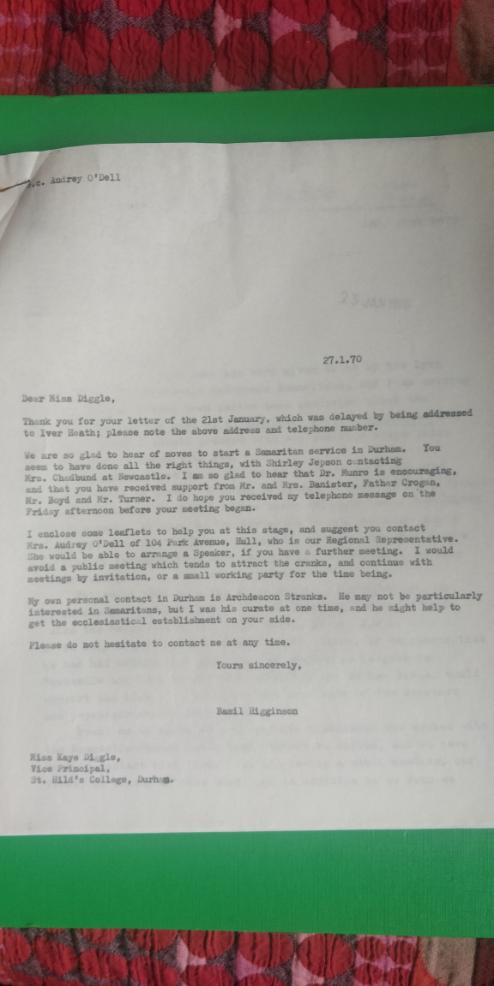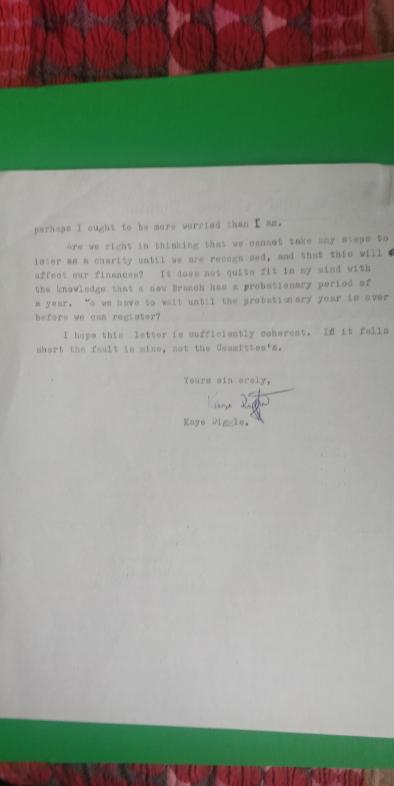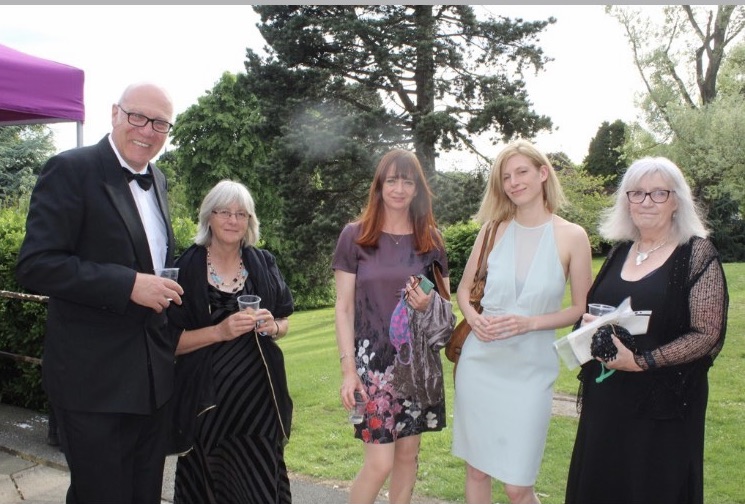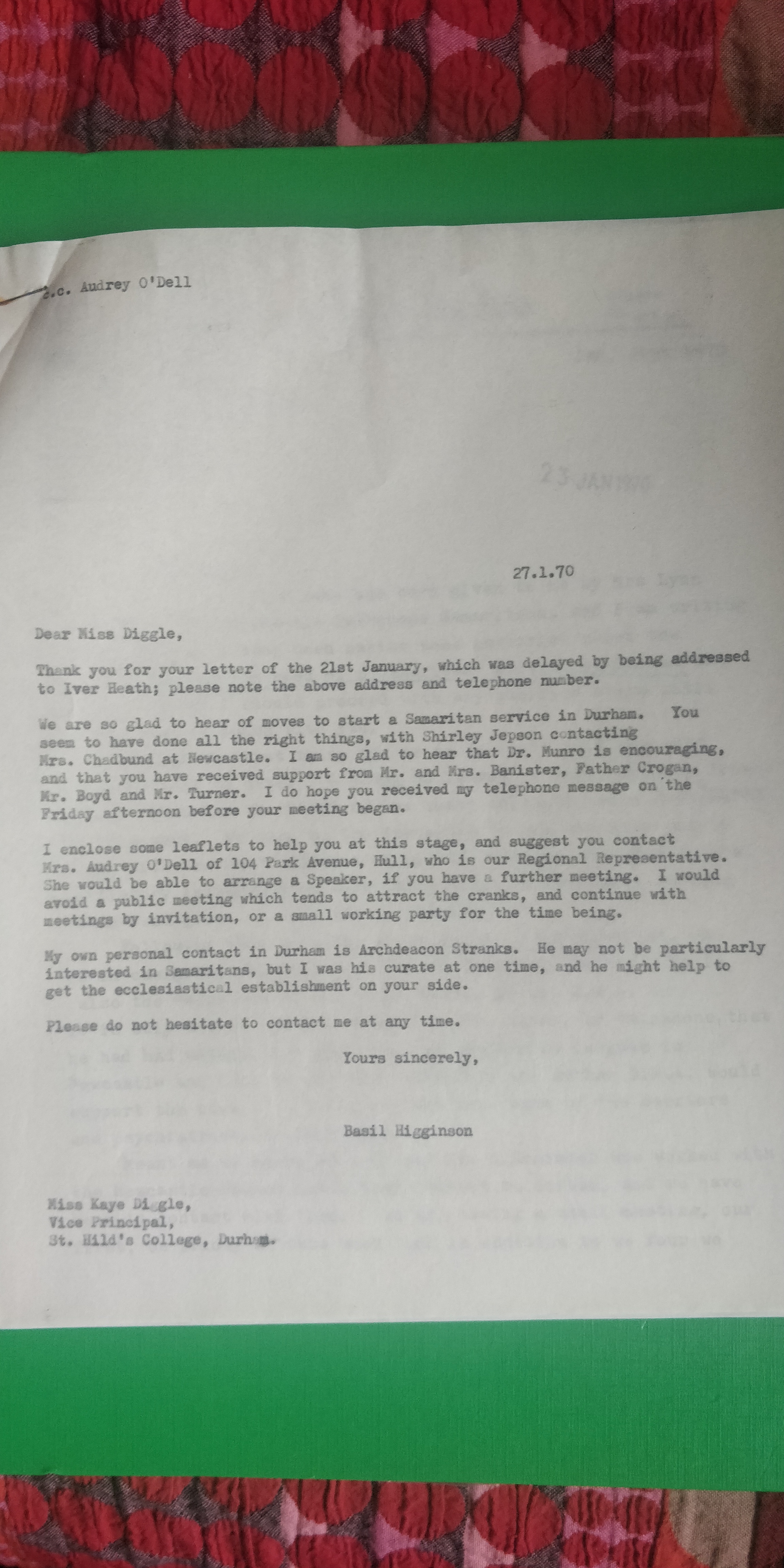Hild Bede and the Samaritans in Durham
Hild Bede has a strong and long tradition of service to our local community. We seek to inspire and to enable our students to be active in supporting the health and welfare and sense of belonging of others. The roots of that tradition are reflected in many aspects of our history. Initially in our foundation as Colleges of teacher training, and since them in our place as the College that brought together volunteering in Durham under the Student Community Association and, in 1970, the opportunity we had to support the founding of the Samaritans branch in Durham.
Miss Diggle has an idea
On January 21st 1970 Miss Kaye Diggle, the Vice-Principal of St Hild’s College wrote to the Reverend Basil Higginson, of the Newcastle Samaritans, seeking to let him know and also ask his advice on the setting up of a Durham branch of the charity. Miss Diggle and her ‘young colleague’ Shirley Jepson had clearly got interested in the idea and reported to the Reverend attending lectures being given to the newly forming Sunderland group. The word had spread and appetites were whetted, because in the same letter Miss Diggle mentions that she had spoken with Dr Munro, a psychiatrist in charge of the students’ health centre in Durham, and been contacted by Mr and Mrs Bannister ‘who worked with the Newcastle branch until they removed to Durham’.
Miss Diggle concluded that along with the College Chaplain, Mr Boyd, and Father Crogan and John Turner, the last two a Roman Catholic and Methodist minister, respectively, the seven named would be meeting that week to consider next steps. Miss Diggle signed off,’ I wonder if you could give us the benefit of your comments. We are anxious to go ahead but have no wish to take any hast or mistaken action’.
Click below to see a copy of Miss Diggle's letter

Rev Higginson replies
Rev Higginson replied on 27th January the delay reflecting the fact that Miss Diggle had sent her letter to the wrong address. The Reverend’s enthusiasm is clear in congratulating her on assembling all the right people and having done ‘all the right things’. He had even placed a telephone call on the afternoon of the meeting planned by Miss Diggle. One likes to think that was to reiterate and to reinforce his support. He sent leaflets and the address of Mrs Audrey O’Dell, the Samaritans Regional Representative based in Hull. Clearly a sage and sensitive adviser, Reverend Higginson also advised, in relation to Miss Diggle’s suggestion that they might move to some public meetings as the project developed, that, ‘I would avoid a public meeting which tends to attract the cranks, and…continue with a small working party for the time being’. His personal connections counted for much as he concluded observing that Miss Diggle might like to contact Archdeacon Stranks (a University alumnus, Archdeacon at Auckland and esteemed churchman after whom, of course, one of the College houses is named). Higginson suggests that Stranks might not be, ‘particularly interested in Samaritans, but I was his curate at one time, and might help to get the ecclesiastical establishment on your side’.
Click below to read Rev Higginson's reply in full

Gathering pace
St. Hild’s College
Durham Durham. 26th 1970
DURHAM TELEPHONE SAMARITANS
Minutes of the meeting held on Wednesday, Feb. 12th at St. Hild’s College.
Present: The Rev. Stephen Davies, the Rev. Fr. Croghan, the Rev. Michael Boyd, the Rev. John Turner,
Miss Shirley Jepson, Miss Kaye Diggle,and Mrs Arthur Banister, Ron Suttleworth, Director of Newcastle Samaritans also attended.
The meeting was conducted formally. Mr Shuttleworth outlined the different ways in which a Samaritan Group could be started and answered questions about the organisation of the Newcastle Samaritans.
He also urged the group to begin to look about immediately for a suitable person who could be invited to become Director of the Durham Branch which is proposed.
The following decisions were taken:
1. A steering committee should be set up of all those present who were willing to join it. This steering committee would have preliminary ground work to do in the following areas:
- Membership and publicity
- Premises
- Finance
2. The following people should be approached and invited to join the steering committee;
- Mr. J. MacKay, Managing Director, Carpet factory.
- Mr. E. Cleaver, N.C.B
- The Rev. P. Brett, University and Hatfield Colleges.
- Mr. J. Heron, Solicitor
- Dr. S. Ludkin M.O.H.
- It was recognised that amongst all these people some would be likely to act in an advisory capacity
3. The Rev. Basil Higginson should be asked to approve the setting up of a branch of the Samaritans in Durham.
4. A. Banister was elected Chairman, and Miss K. Diggle Secretary of the Steering Committee pro. tem.
Miss Diggle drew the attention of the meeting of an invitation from the Darlington Branch to a weekend conference, to be held in Darlington on March 21 and 22.
The next meeting will be on March 13th, 8 p.m. at St. Hild’s
K.A.Diggle
A final push
Shortly after the meeting at the end of February, on 5th March, Kay Diggle wrote once again to Rev Higginson seeking his approval for the formation of the Durham branch. Things were moving fast towards a conclusion. The branch steering committee had been formed, advice on establishment as a charity sought – Miss Diggle thought perhaps that could wait until after a year of probationary operation – and now Rev Higginson was being asked for his thoughts on what was to be the agenda for the next meeting and whether the branch could launch without, in the immediate and short-term a Director.
You can see Miss Diggle's letter of 5th March (page 1) via the link below
Miss Diggle's letter of 5th March 1970
And, read page 2 at this link
Miss Diggle's letter of 5th March (page 2)


DURHAM TELEPHONE SAMARITANS
Meeting of the Steering Committee, March 13th 1970
At St. Hild’s College at 8 p.m.
AGENDA
- Minutes of the meeting of February 11th.
- Matters arising;
Item 2
Item 3.
3. Literature available.
4. Consideration of the structure of the Durham Branch of the Telephone Samaritans:
- The Director.
- 24 hour service.
- Committee
5. Immediate action to be taken by working parties:
- Business and Finance.
- Registering as a charity.
- Promises of money.
- Application for a launching grant.
- Membership and publicity:
- Invitation to various welfare bodies to an informative meeting.
- Organisation of the meeting.
- Public meeting, also to spread information.
- Premises and Phones:
- Approach various authorities to enquire about possible premises. Church, Council, …
- Approach G.P.O. about telephones.
- Office and Programme planning:
- Record keeping,
- Filing system, and register.
6. Date of next meeting.
Kaye Diggle, Secretary
You can see a copy of this agenda by clicking the link below
Over the line
THE SAMARITANS
17 Uxbridge Road,
Slough, Bucks.
Memorandum
TO: Jean, Vera, Margaret (Please tick and pass on)
FROM: ______BH______________
DATE: __1st March 1970__________
Subject: ____Durham____
_______________
?? for Branch List
122 DURHAM Central Durham Samaritans,
(N.E. Region) 57 Sadler St., Durham
Telephone: Durham 63777 (E)
Durham 63737 (O)
Office Manned Director: The Revd Gordon Roe
09.00 -07.00 Sec: Miss Kaye Diggle
No. of Branches now operating in UK - 115
(+Dublin 1
+ Overseas 9)
Add to Branches in UK (in order of date)
122 Durham 1971 March 5th Central Durham Samaritans
ITEMS to ask BRANCHES on TELEPHONE
?? No 1 & 4 (? of management ? orders
Keep Nos 2 & 3 (Branch Return Estimate of Income)
A connection revived: 2021
The current Director of Durham Samaritans, Lynn contacted us in March 2021 to share with us the correspondence summarised here and copies of which are to be found attached to this webpage. Lynn also invited us to join her in celebration of 50 years of the Samaritans in Durham. You can see information about Durham Samaritans and this celebration here.
Not only were we delighted to better understand our links to the Durham Samaritans, but also to have Lynn as a guest of honour at our ‘Charities formal’ for which Samaritans was one of the nominated charities to which we donated funds raised by our students.
At this time, we discovered that Lynn in in fact an alumna of St Hild’s College and came up in the Autumn of 1970, the very year the Samaritans in Durham was founded. We have recently invited Lynn to join our Senior Common Room in order to cement our connection.

Lynn Brooks (r) pictured with (from the left, Simon Forrest, Shona Kennerley, Laura Todd, Vice Principal and Stephanie Maurel, Alumni Relations and Engagement Officer
Mental health and suicide in the UK: the story in the 1960s and 1970s
The Samaritans was founded in 1953 by Chad Varah, a vicar in the Church of England based in London. It is said that Varah was inspired by his experience as a curate of taking the funeral of a 14 year old young woman who killed herself because she feared she has contracted a sexually transmitted disease. She was in fact menstruating. The movement grew rapidly, in 1959 a second centre opened in Edinburgh and by the early 1960s there were 40 branches across the UK.
The Samaritans arose from a single person’s experiences and deep desire to act in support of people contemplating suicide, but it clearly met a wider need as well as struck a chord with others willing and wanting to help.
The foundation of the Durham branch and the contemporary burgeoning of branches elsewhere came at time when rates of suicide were in in fact in decline. But, this was after having reached a post-war peak in the early 1960s. Rates then declined steadily in both genders between 1963 and 1975. The suicide rate for males declined from 145 per million in 1963 to 91 per million in 1975. There was a similar decrease amongst women from 99 per million in 1963 to 60 per million in 1975. The rates amongst men and women latterly diverged with an increase in male suicide between 1974 and 1990. Fluctuations continue with an overall decrease between 1990 and 1997 although the gender difference remains.
It has been suggested that rates of suicide relate a variety of factors ranging from access to means, environmental and socio-cultural factors. It has been argued for instance, that between 1963 and 1975 the decrease in suicides may have been due to a decrease in the availability of poisonous domestic gas and also barbiturates. It has also been suggested that male suicide may thereafter rise because of the lethality of the methods to which men turned.
Whilst means and methods may in part explain the numbers of suicides it is a weaker explicative for motive. Psychosocial stresses are regarded as important in this regard. Between 1975 and 1990 there were increases in male unemployment and violence both of which are related to suicide. Social isolation, alienation and loneliness increased alongside the number of single-person households and the numbers of divorced males who had not re-married. Debt rose and so too did homelessness. Substance misuse and alcohol consumption, which have been shown to be associated with suicide rate, increased between 1975 and 1990. McClure (2000) suggests a link warranting further research between increase in numbers of economically active married women, the doubling of the prevalence of lone-mother families from 9% to 18% during the same period, and the delayed age of marriage of women.
It is suggested that stigma, both with regard to mental health and wellbeing, coping and help-seeking, has an impact on suicide and attempts to provide suicide prevention. Public stigma and discrimination in relation to mental health and wellbeing as a whole, has wide-ranging and significant consequences for those affected including being associated with self-stigmatisation, disadvantages in relation to employment, higher prevalence of suicide, lower perceived health status, and lower rates of help-seeking for mental health problems.
There is a dearth of attitudinal research for the period between 1950-70 but recent work using data for the period 2003 and then 2007-2013 gathered in the UK using the national Attitudes Mental Illness Survey, suggests the development of more positive attitudes, tolerance and understanding of mental ill-health and suffering. However, this is not the case universally within the population with women, those aged between 45 and 64 years old and of higher socioeconomic status more likely to report more positive attitudes. Support for care in community for people with significant mental ill-health is reported to be low and more negative attitudes coalesce around public concerns about risk to others and where prejudices and awareness of specific conditions in low.
The policy and legal context is also significant and until 1961 suicide was a crime in England and Wales although it has been suggested that changes in the law lagged behind public opinion with regard to de-criminalisation. Notably, the engagement of a number of clergy representing three denominations in the planning and establishment of Durham Samaritans may reflect the significance and importance of ecclesiastic views in shaping law and public attitudes.
Sources
Evans-Lacko, S., Corker, E., Williams, P., Henderson, C., & Thornicroft, G. (2014). Effect of the Time to Change anti-stigma campaign on trends in mental-illness-related public stigma among the English population in 2003–13: an analysis of survey data. The Lancet Psychiatry, 1(2), 121-128.
McClure, G. M. G. "Changes in suicide in England and Wales, 1960–1997." The British Journal of Psychiatry 176, no. 1 (2000): 64-67.
Neeleman, Jan. "Suicide as a crime in the UK: legal history, international comparisons and present implications." Acta Psychiatrica Scandinavica 94, no. 4 (1996): 252-257.



/prod01/prodbucket01/media/durham-university/colleges/college-of-st-hild-amp-st-bede/location-images/04E9EFC9-15A7-41D3-ADF5-19AAAD386967.jpg)
